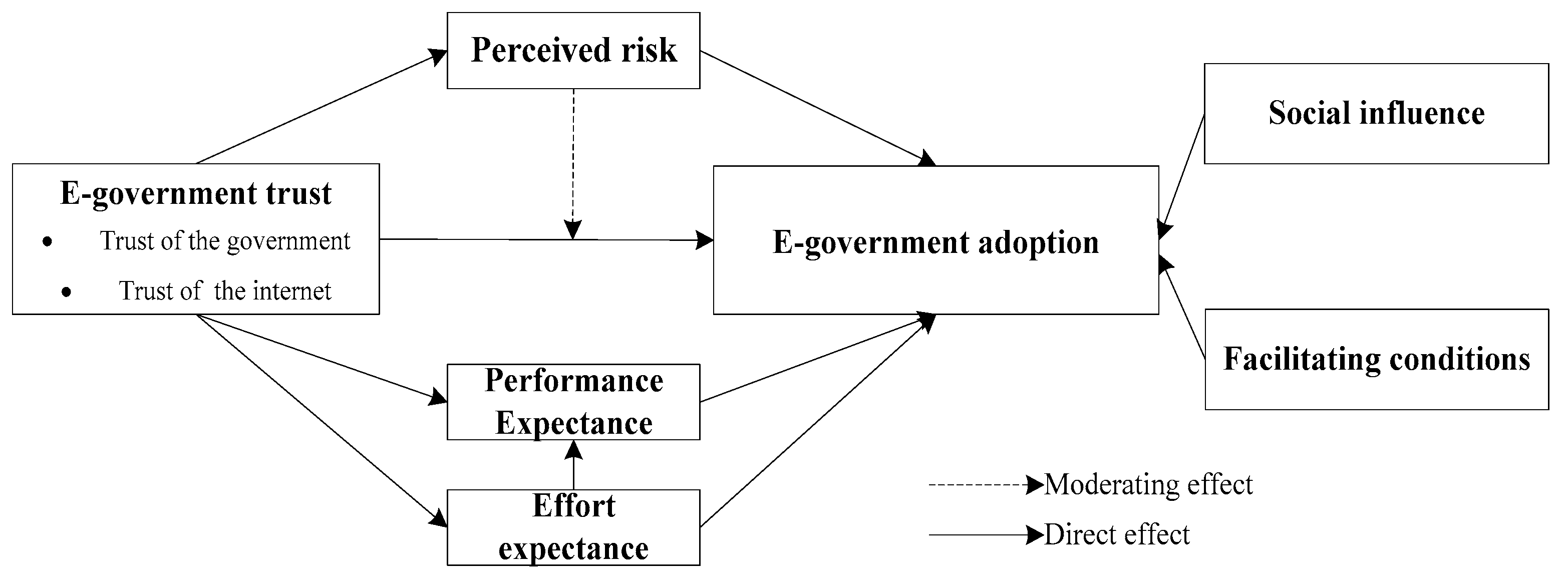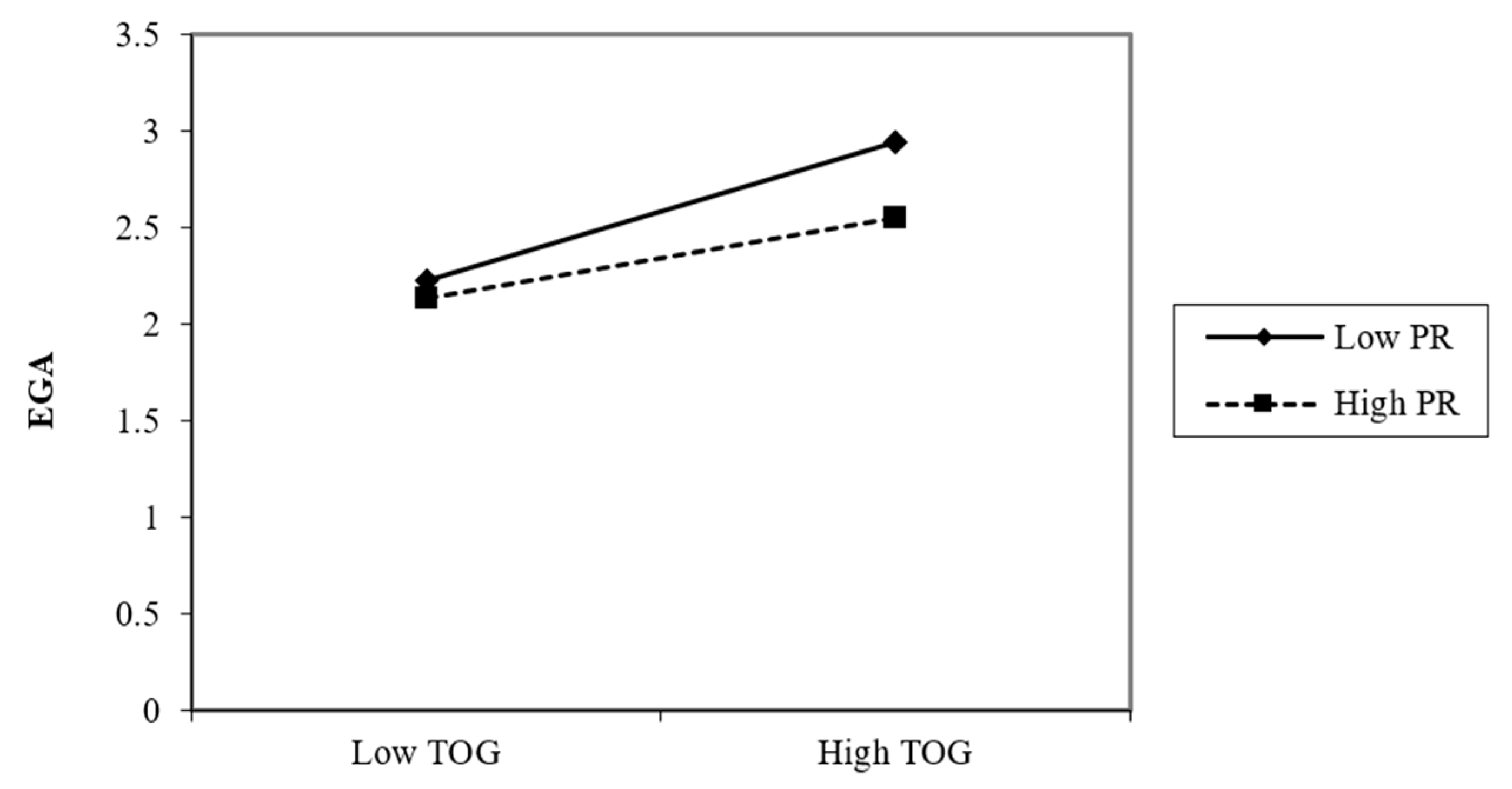2.2.1. Trust, Risk, and Citizens’ E-Government Adoption
Trust, as a relationship between trustor and trustee, has attracted the attention of scholars in sociology, political science, and economics for nearly half a century. Their studies focused on how trust affects organisations, society, and political systems. With the rapid development of e-government worldwide, more and more scholars have begun to pay attention to the impact of trust on e-government adoption. There are a variety of definitions and operational scales of trust in existing studies. Nevertheless, all these conceptions of trust are related to the trustee, namely the object of trust. For instance, Papadopoulos et al. (2010) proposed a comprehensive typology of trust in e-government (seven different types, conceptualised around the different targets they are related to), including trust in data, trust in service, trust in information, trust in the transaction, trust in government organisation, and institution-based trust [
11]. In the case of e-government in China, the main objects of trust include public organisations which provide information and services for users, and the internet which delivers information and services to users. Furthermore, numerous studies have suggested that trust in e-government is composed of trust in an entity (trust in government) and trust in the reliability of the enabling technology [
9]. Hence, this study focuses on both trusts: trust of the government (TOG) and trust of the internet (TOI).
Trust of the government (TOG) is citizens’ belief in the ability and integrity of the government. Research studies on organisational behaviour showed that employees’ trust in an organisation enables them to have positive attitudes and take positive actions. Regarding e-government adoption, numerous studies have proven that trust of the government has a positive influence on the citizens’ intention to use e-government, which is an important predictor of citizens’ e-government adoption [
1,
8,
12,
13,
14,
15,
16]. When citizens have a higher level of trust in government, they tend to be close to government agencies (participate in public affairs, collect government information, and care about national affairs, etc.). Therefore, the first hypothesis of this study is proposed.
Hypothesis 1 (H1). TOG positively influences citizens’ e-government adoption.
Trust of the internet (TOI), as institution-based trust, refers to one’s perceptions of internet security policies and regulations that make him or her feel safe. As the internet is the carrier for delivering e-government services to citizens, trust of the internet is consistently identified as a key predictor of e-government adoption. According to existing studies, trust of the internet has a positive effect on e-government adoption [
1,
9,
17]. These studies argued that citizens believe that the internet is reliable and secure, and could support error-free, secure transactions, and increase the users’ willingness to use e-government. Influenced by the above literature, the second hypothesis of this study is proposed.
Hypothesis 2 (H2). TOI positively influences citizens’ e-government adoption.
Perceived risk (PR), as citizens’ subjective expectation of suffering a loss in pursuit of the desired outcome [
18], is an important predictor of citizens’ e-government adoption [
4,
6,
15,
19,
20], as well as a crucial factor in m-commerce that influences user’s use behaviour [
21]. Regarding e-government, perceived risk is composed of the perception of exposure of personal information, privacy, and the loss of money. Numerous studies have already investigated perceived risk and its influence on citizens’ e-government adoption, which found there is a significant and negative relationship between perceived risk and citizens’ e-government adoption. The perceived risk reduces citizens’ intentions to exchange information and transact affairs on the internet [
18]. Drawing from these studies, the following hypothesis is proposed.
Hypothesis 3 (H3). PR negatively influences citizens’ e-government adoption.
The relationship between trust and perceived risk has been explored by some empirical studies [
1,
8,
9,
22,
23]. The results of these studies are different. For instance, Carter et al. ’s study suggested that trust of the internet has a positive and significant effect on the perception of risk, and trust in government has a positive but not significant effect on perceived risk [
9]. Lee and Song’s study showed that trust in the capabilities of an organisation that provides e-government services to citizens has a significant and negative effect on perceived risk [
8]. However, these studies came from different countries, and thus, cultural factors might have influenced the results. Theoretically, trust can reduce uncertainty and risk. Therefore, this study proposes the following hypotheses.
Hypothesis 4 (H4). Higher levels of TOG will reduce the PR of citizens’ e-government adoption.
Hypothesis 5 (H5). Higher levels of TOI will reduce the PR of citizens’ e-government adoption.
In addition, this study tries to explore the moderating effect of perceived risk between trust and e-government adoption. A higher level of trust will increase the citizens’ willingness to use e-government. However, the perception of risk will reduce citizens’ attention to use e-government. Therefore, we want to know whether perceived risk plays a moderating role between trust and e-government adoption. From the citizens’ perspective, if citizens have the same level of trust in government or the internet, they might tend to use e-government services. However, if they perceive high risks during this process, they might give up using e-government services. The perceived risk might have a negative moderating effect on the relationship between trust and e-government adoption. Depending on these arguments, this study proposes the following hypotheses.
Hypothesis 6 (H6). PR has a negative moderating effect on the relationship between TOG and citizens’ e-government adoption.
Hypothesis 7 (H7). PR has a negative moderating effect on the relationship between TOI and citizens’ e-government adoption.
2.2.2. UTAUT and Citizens’ E-Government Adoption
UTAUT, as the classic information technology and information system acceptance model, is widely used in the field of information technology adoption and acceptance. UTAUT integrated eight models, such as the technology acceptant model (TAM), theory of reasoned action (TRA), theory of planned behaviour (TPB), motivation model (MM), innovation diffusion theory (IDT), and social cognition theory (SCT). UTAUT and extending the unified theory of acceptance and use of technology (UTATU2) proposed that performance expectancy (PE), effort expectancy (EE), social influence (SI), and facilitation conditions (FC) have a positive effect on the adoption of information technology or information systems [
24,
25]. These four major constructs: PE, EE, SI, and FC, present core constructs of other information adoption models such as perceived usefulness (PU), perceived ease of use (PEOU), and subjective norms (SN), etc. However, UTAUT was developed in the job context. Therefore, it is very necessary to verify the applicability of this model in e-government adoption. Fortunately, some existing studies have already verified that PE, EE, SI, and FC positively correlated with e-government adoption [
26,
27]. These studies argued that citizens’ perception of usefulness, ease of use, social influence, convenient internet, and PC/mobile phone are significant to citizens’ e-government adoption. Therefore, the following four hypotheses are offered.
Hypothesis 8 (H8). EE will positively influence citizens’ e-government adoption.
Hypothesis 9 (H9). PE will positively influence citizens’ e-government adoption.
Hypothesis 10 (H10). SI will positively influence citizens’ e-government adoption.
Hypothesis 11 (H11). FC will positively influence citizens’ e-government adoption.
In addition, there is also a relationship between PE and EE. In the TAM, PEOU has a significant positive effect on PU [
28]. In the UTAUT, EE has a positive effect on PE [
24,
25]. Some studies have already used TAM and UTAUT in the area of e-government adoption, which also proved the positive and significant effect of PEOU on PU and EE on PE [
8,
29]. According to TAM and UTAUT, the hypothesis is proposed.
Hypothesis 12 (H12). EE will positively influence PE.
2.2.3. Trust and UTAUT
As aforementioned, the existing research has introduced trust into UTAUT to explore the influence of trust on the core variables of this model. Particularly in the field of e-business, existing research has also proven that trust has a significant impact on PE and EE [
30,
31,
32]. Similarly, trust, as an external variable, has been introduced in TAM, and their results indicated that trust is positively associated with PU and PEOU [
33]. In the research of e-government field, previous studies have drawn the similar conclusions. Lee and Song (2013) introduced the citizens’ organisational trust into UTAUT, whose results also proved that trust has a positive effect on both PE and EE [
8]. Although the concept of trust in these studies is multi-dimensional, it essentially covers the trust in organisations that provide services, and the internet or technology that deliver the services. Therefore, this study proposes the following four hypotheses.
Hypothesis 13 (H13). TOG positively influences EE.
Hypothesis 14 (H14). TOI positively influences EE.
Hypothesis 15 (H15). TOG positively influences PE.
Hypothesis 16 (H16). TOI positively influences PE.









